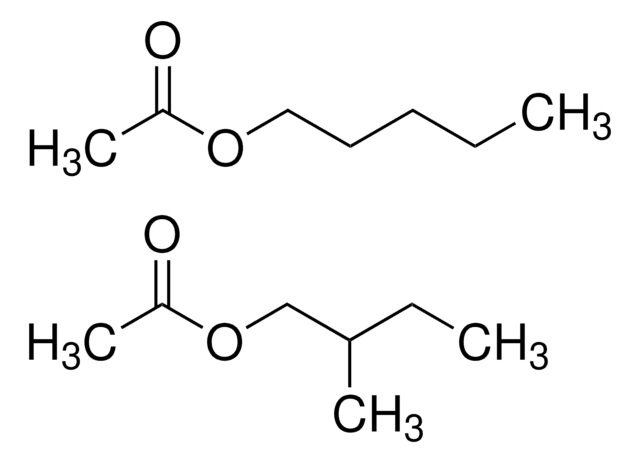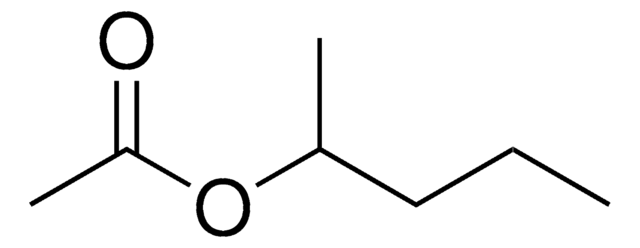46022
Pentyl acetate
puriss. p.a., ≥98.5% (GC)
Synonyme(s) :
Amyl acetate
About This Item
Produits recommandés
Densité de vapeur
4.5 (vs air)
Niveau de qualité
Pression de vapeur
4 mmHg ( 20 °C)
Qualité
puriss. p.a.
Essai
≥98.5% (GC)
Température d'inflammation spontanée
680 °F
Impuretés
≤1% isopentyl acetate
Indice de réfraction
n20/D 1.402 (lit.)
n20/D 1.403
pb
142-149 °C (lit.)
Pf
−100 °C (lit.)
Densité
0.876 g/mL at 25 °C (lit.)
Traces de cations
Al: ≤0.5 mg/kg
Ba: ≤0.1 mg/kg
Bi: ≤0.1 mg/kg
Ca: ≤0.5 mg/kg
Cd: ≤0.05 mg/kg
Co: ≤0.02 mg/kg
Cr: ≤0.02 mg/kg
Cu: ≤0.02 mg/kg
Fe: ≤0.1 mg/kg
K: ≤0.5 mg/kg
Li: ≤0.1 mg/kg
Mg: ≤0.1 mg/kg
Mn: ≤0.02 mg/kg
Mo: ≤0.1 mg/kg
Na: ≤0.5 mg/kg
Ni: ≤0.02 mg/kg
Pb: ≤0.1 mg/kg
Sr: ≤0.1 mg/kg
Zn: ≤0.1 mg/kg
Groupe fonctionnel
ester
Chaîne SMILES
CCCCCOC(C)=O
InChI
1S/C7H14O2/c1-3-4-5-6-9-7(2)8/h3-6H2,1-2H3
Clé InChI
PGMYKACGEOXYJE-UHFFFAOYSA-N
Vous recherchez des produits similaires ? Visite Guide de comparaison des produits
Catégories apparentées
Description générale
Application
Mention d'avertissement
Warning
Mentions de danger
Conseils de prudence
Classification des risques
Flam. Liq. 3
Risques supp
Code de la classe de stockage
3 - Flammable liquids
Classe de danger pour l'eau (WGK)
WGK 1
Point d'éclair (°F)
105.8 °F
Point d'éclair (°C)
41 °C
Équipement de protection individuelle
Eyeshields, Faceshields, Gloves, type ABEK (EN14387) respirator filter
Faites votre choix parmi les versions les plus récentes :
Déjà en possession de ce produit ?
Retrouvez la documentation relative aux produits que vous avez récemment achetés dans la Bibliothèque de documents.
Notre équipe de scientifiques dispose d'une expérience dans tous les secteurs de la recherche, notamment en sciences de la vie, science des matériaux, synthèse chimique, chromatographie, analyse et dans de nombreux autres domaines..
Contacter notre Service technique







